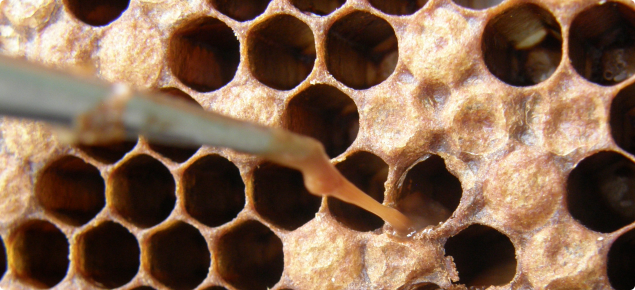Infection of hives
American foulbrood disease is caused by bacteria and is transmitted through spores. Very young larvae are highly susceptible to infection. As few as 10 spores can infect a larva less than a day old.
Infected larvae are killed by the bacteria before pupation and at this stage as many as 2.5 billion spores per larva may be released. These spores may survive at least 40 years. They are resistant to drying and boiling in hot water.
The spores may be introduced through contaminated equipment from other hives or from another bee colony by contaminated ‘robber’ or drifting bees. Unsterilised tools may also be a source of contamination.
Young larvae swallow the bacterial spores in infected food from nurse bees. The bacteria multiply in the larval tissue causing rapid death, and the spores are spread to other larval cells as well as the honey cells by worker bees attempting to remove the dead larvae. Eventually, numbers of adult bees decline and the hive becomes weak and dies out.
Bee colonies usually abscond (swarm) when this happens. This dead hive may attract robber bees from neighbouring hives which can spread the disease further.
Signs of infection
The first signs of American foulbrood are sunken and damaged cappings on the sealed brood.
The dead larvae turn yellow at first and then chocolate brown and are drawn down into the cells. On stirring with a probe such as a matchstick, the contents of the cell may rope out forming a characteristic fine elastic thread up to 30mm long.
In more advanced stages of the disease, the larval remains become tacky and gradually dry out to a dark brown scale. Good lighting is required to observe these scales as they are similar in colour to dark brood combs.
What to do
Whenever a colony dies out or an irregular pattern of brood is observed, the combs should be examined for sunken and perforated cappings or dried larval scales. If anything resembling them is found, a sample of comb and larvae should be submitted immediately to the Department of Agriculture and Food for laboratory examination.
The remaining combs should be left in the hive. The hive should be physically identified and made bee-tight until a report on the condition of the sample has been received.
Note: An apiary inspector must be notified within 48 hours of suspecting American foulbrood.
If foulbrood is identified, the beekeeper and an apiary inspector will agree on a management plan to eradicate the disease from the apiary. All brood will be inspected and diseased hives removed before honey extraction and movement of hives. Hives can still be moved to their normal honey or pollen sites with permission of the inspector.
Diseased hives can be either decontaminated by irradiation or wax dipping, or destroyed. Some hive components can be decontaminated using 1% sodium hypochlorite.



